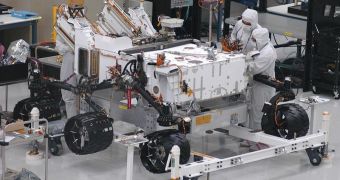Later this year, NASA is scheduled to launch its next flagship mission to the Red Planet. However, experts are now raising concerns that some of the materials on the rover may start to leak methane, which would confuse the sensitive sensors on the robot into giving false readings.
One of the primary areas of the mission is astrobiology, and analyzing the composition of Martian methane is a key objective. But doing so requires absolute certainty that no contamination exists.
Spacecraft routinely carry substances and microorganisms from Earth to other space objects. Rigorous clean-up processes are therefore applied to ensure that biological contamination does not happen.
But what if the source of contamination is not on the spacecraft, but is the spacecraft itself? Experts have recently found that, under certain conditions, the material NASA uses as duct tape on its next rover may leak methane.
The Mars Science Laboratory (MSL) rover, called Curiosity, is being sent to Mars to discover the origins of the methane that orbiters identified on the Red Planet from outer space. Being exposed to other sources of methane as well would confuse the spacecraft's sensors.
The new study was conducted by University of Florida (UF) microbiologist and veteran Mars simulator Andrew Schuerger, and was published in the latest issue of the esteemed journal Icarus.
He and his team looked at the material commonly used to keep rover joints together, and determined that the duct tape-like material could release just enough methane to become a problem once on Mars.
“I think it’s a valid concern. We’re sending a very very sensitive instrument, and we are able to produce concentrations of methane that are orders of magnitude above the detection limits for that instrument,” explains Adam Johnson.
The expert, who holds an appointment as a planetary scientist at the Indiana University, was not a part of the new investigation, Wired reports. “Andrew’s simulation setup in his chamber is state of the art, the best simulation chamber in the world,” he adds.
At this point, the Mars Simulation Chamber that Schuerger operates is the most faithful reproduction of Martian conditions available on Earth. The stainless steel cylinder can mimic the atmosphere, dustiness, sunlight, temperature and pressure that exist on the Martian surface.
In the latest simulations, experts also placed some kapton tape inside the Chamber. About 3 square meter of this material will be put on the MSL, more than in any other explorations robot to date.
“It’s a big monster rover. They use the appropriate level of tape to secure that stuff down. There’s just more of it than there might have been on [Spirit and Opportunity],” says MSL Sample Analysis at Mars (SAM) instrument manager and NASA planetary scientist Paul Mahaffy.
These simulations are bound to help experts determine which of the readings coming from Mars are accurate, and which of them are false-positive. If they did not know about the kapton tape methane emissions, then subsequent studies may have led science on a wrong path.

 14 DAY TRIAL //
14 DAY TRIAL //